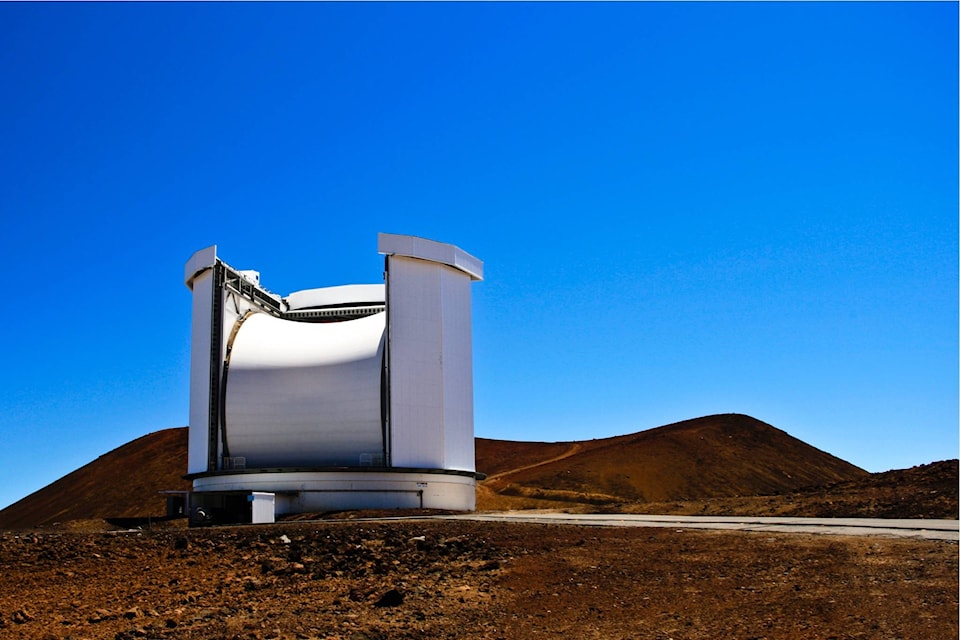Thirty-some years ago, one of my radio astronomy colleagues at NRC pronounced that “One way or another, he was going to detect water on Mars.”
This was years before there would be any prospect of landing a spacecraft on the red planet and look around for water. He was using a large radio telescope, the 46-metre dish at the Algonquin Radio Observatory, in Ontario. That instrument, equipped with what was at the time state-of-the-art receiving systems, had played a part in a number of world radio astronomy firsts, and was well-suited to the job.
The idea was to look for a characteristic radio emission produced by water molecules. This radio signature is at a wavelength of about 1.35 cm. The idea was basically simple, to point the dish at Mars for long periods, hoping to collect enough signal to add up to a detectable “spike” at that wavelength. Unfortunately, despite intense efforts, he was not successful. Although we now know there is a lot of water on Mars, there is not much of it in the atmosphere, where it would be producing that radio signature. Despite problems like this, studying the radio signatures of water and other molecules has become an extremely important branch of astrophysics. It shows us what is going on in those dark, cold cosmic clouds and gives us important insights into the processes that made the foundation for the appearance of living things.
The most important radio signature of the lot is that of cold, neutral hydrogen gas in space. Since hydrogen is the most common element in the universe and is involved in the formation of stars, galaxies and other things, it is a powerful stethoscope on cosmic processes. The radio signature has a wavelength of 21.1 cm. Since there is a lot of hydrogen out there, the signal is a strong one and relatively easy to pick up.
From the number of icy objects, we can see in space, we can conclude there is a lot of water out there, and despite that lack of success with Mars, we are detecting its presence in most cosmic clouds. There are lots more radio signatures that have been detected, such as ammonia, at about 1.3 cm wavelength, formaldehyde (6.2 cm wavelength), carbon monoxide (2.6 mm), methanol (4.5 cm) and many others. Most of these molecules radiate their radio signatures at very short (millimetre) wavelengths. Since their relative concentrations and reactions tell us much about star and planet formation, and about life, cosmic molecules have become a very important branch of astrophysics, and special radio telescopes have been built to observe them. Two such instruments in which Canada has participated are the James Clerk Maxwell Telescope, on Mauna Kea in Hawaii, and the Atacama Large Millimetre Array, in Chile. The problem now is that although a very large number of molecular signatures have been detected we have as yet only identified a fraction of them. In the cold, dark, cosmic dust and gas clouds the elements produced by stars will react very slowly, but billions of years have been enough time for a lot to have happened.
Laboratory experiments have shown us that under the right conditions, in the atmospheres of young planets, they can react to form amino acids, the building blocks of proteins and life as we know it. This may give us the impression cosmic processes favour the formation of carbon-based life, like us. However, that conclusion is a bit premature. We are of course biased toward searching for life processes with which we are familiar, like ours. What are those unidentified molecules up to? Can there be a life that is not based on molecules at all? In our huge, old universe, almost anything is possible. We need to keep our telescopes going and our minds as open as possible.
Mars, fading as it recedes, lies in the south after dark. Venus and Jupiter shine low in the dawn glow. The moon reaches first quarter on Jan. 13.
Ken Tapping is an astronomer with the National Research Council’s Dominion Radio Astrophysical Observatory.
Steve Kidd
Senior reporter, Penticton Western News
Email me or message me on Facebook
Follow us on Facebook | Twitter | Instagram
